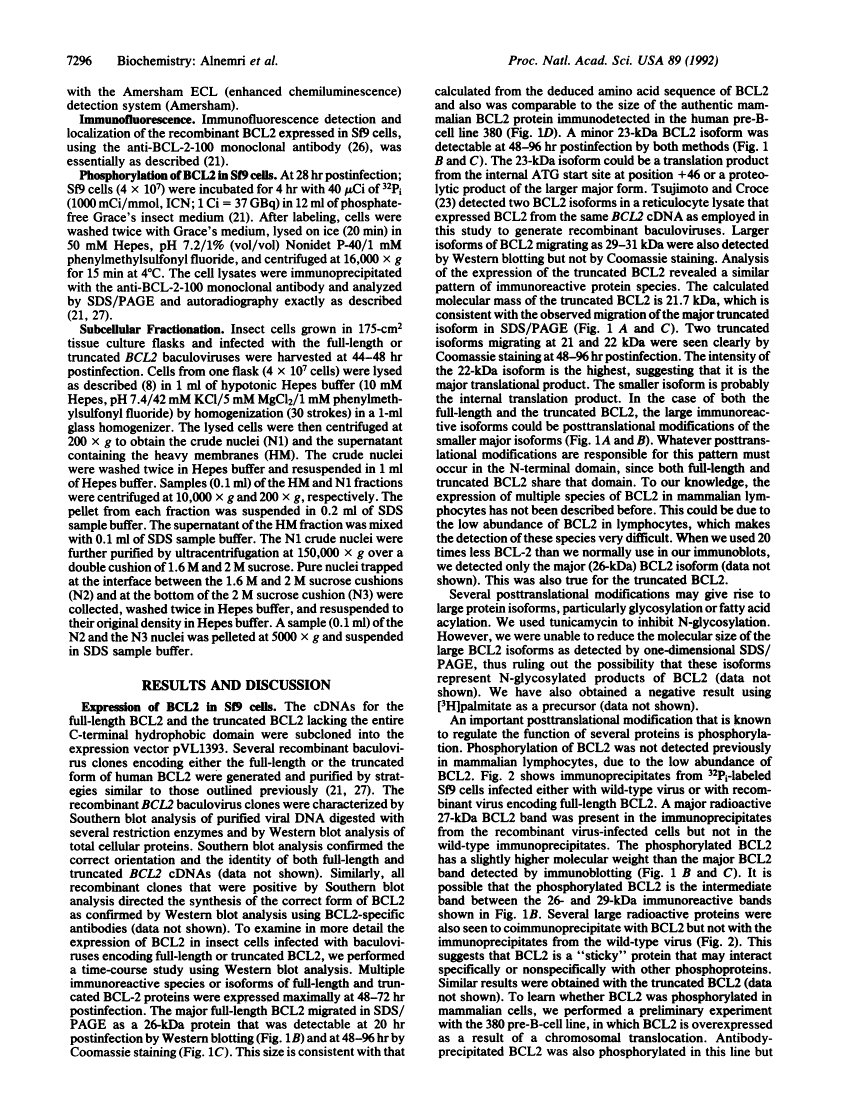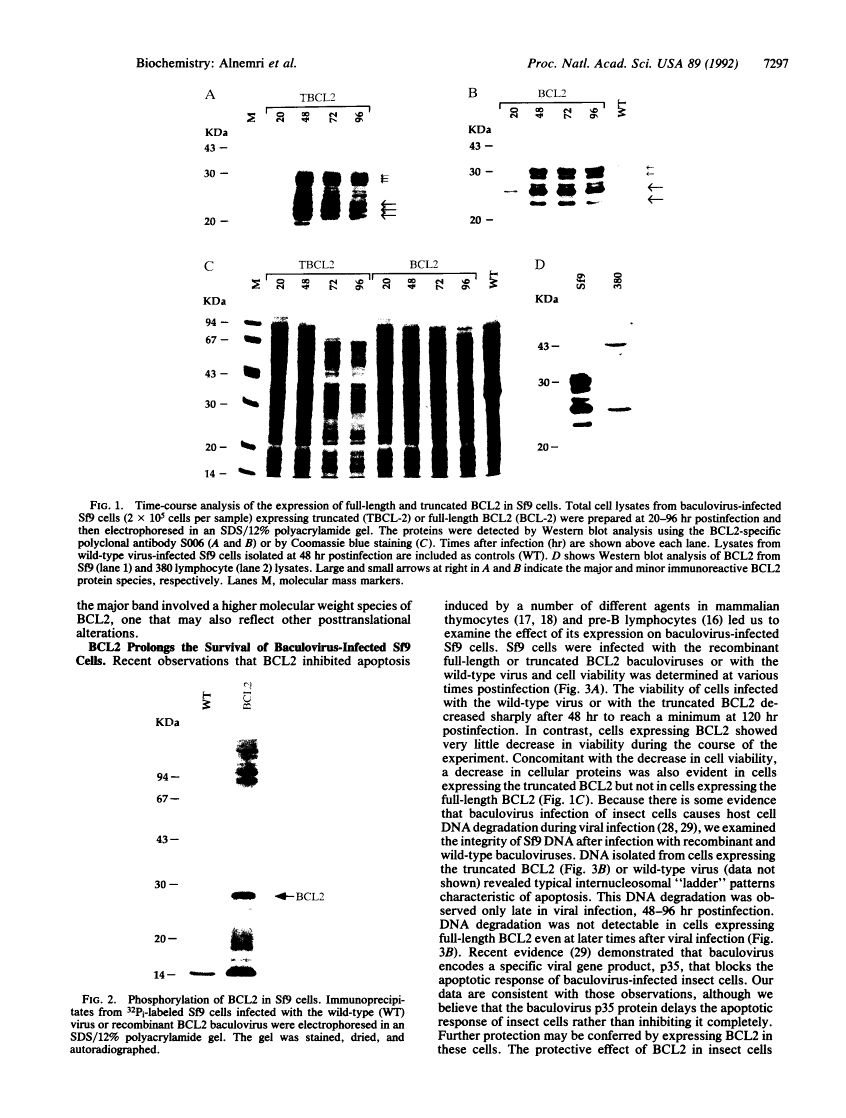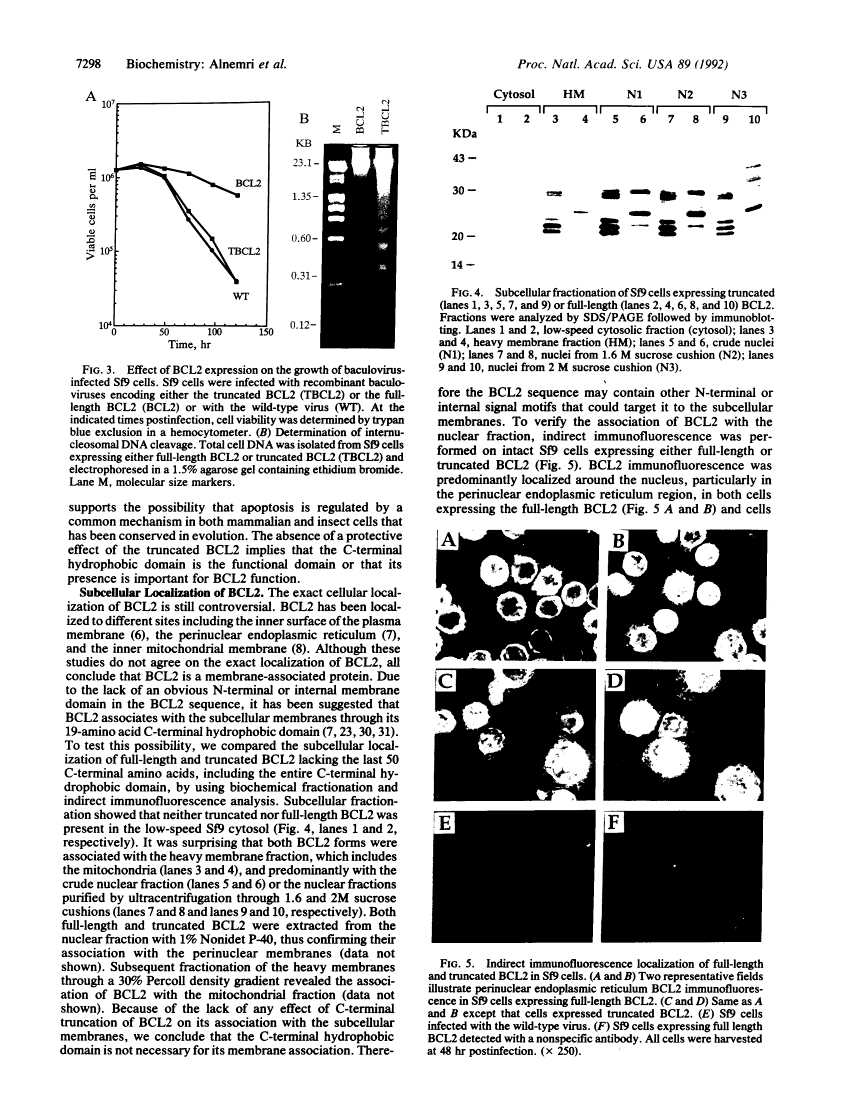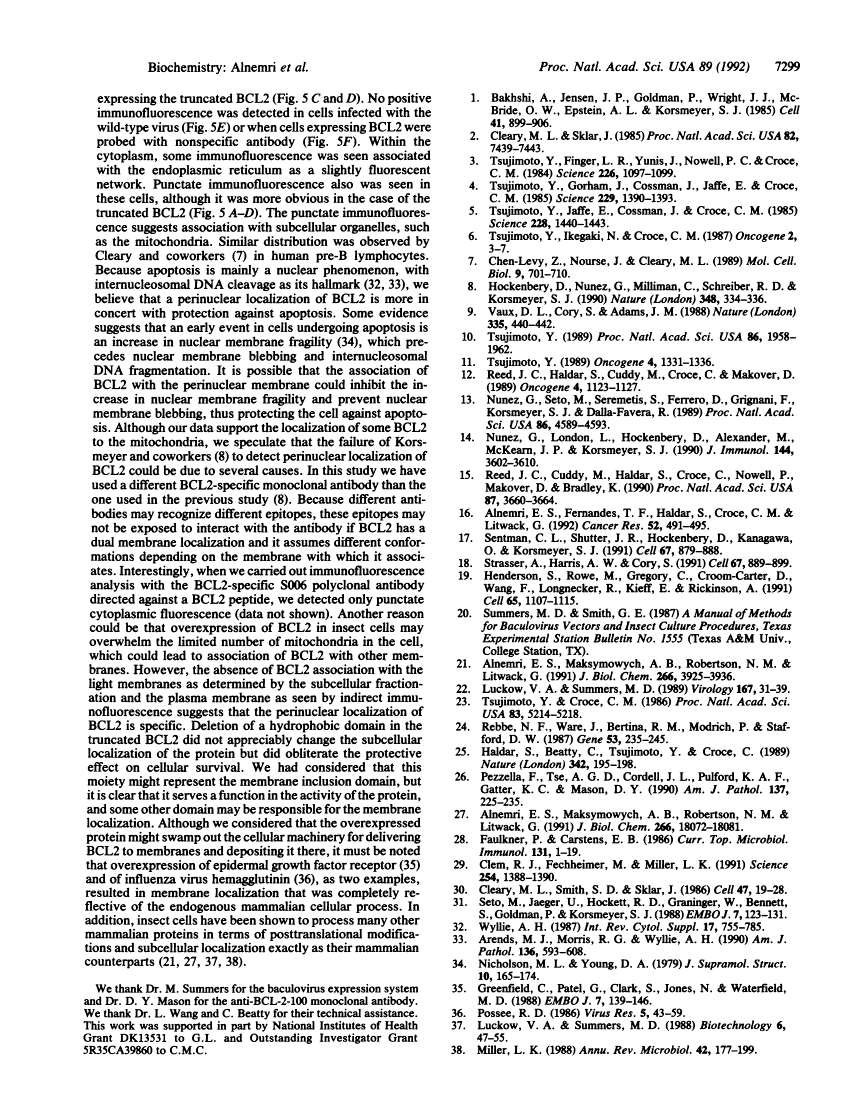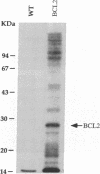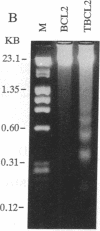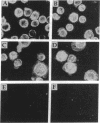Abstract
Free full text

Overexpressed full-length human BCL2 extends the survival of baculovirus-infected Sf9 insect cells.
Abstract
Full-length and truncated human BCL2 lacking the entire C-terminal hydrophobic domain have been overexpressed in Spodoptera frugiperda insect cells with the baculovirus expression system. Immunoblot analysis with BCL2-specific antibodies revealed that both full-length and truncated BCL2 are expressed as multiple immunoreactive species, suggesting posttranslational modifications. The expression of the full-length but not the truncated BCL2 extended the survival of baculovirus-infected cells by preventing virus-induced DNA cleavage. This result is consistent with the reported protective effect of BCL2 against apoptosis in mammalian lymphocytes and suggests a conserved function in evolution. Subcellular fractionation and indirect immunofluorescence studies in intact cells demonstrated that the recombinant full-length and truncated BCL2 proteins were expressed predominantly as nuclear membrane-associated proteins. These results imply that BCL2 must utilize hydrophobic domains other than the deleted domain for its association with the subcellular membranes. Metabolic labeling of insect cells expressing the full-length and the truncated form of BCL2 with 32P(i) demonstrated that BCL2 is a phosphoprotein.
Full text
Full text is available as a scanned copy of the original print version. Get a printable copy (PDF file) of the complete article (1.5M), or click on a page image below to browse page by page. Links to PubMed are also available for Selected References.
Images in this article
Click on the image to see a larger version.
Selected References
These references are in PubMed. This may not be the complete list of references from this article.
- Bakhshi A, Jensen JP, Goldman P, Wright JJ, McBride OW, Epstein AL, Korsmeyer SJ. Cloning the chromosomal breakpoint of t(14;18) human lymphomas: clustering around JH on chromosome 14 and near a transcriptional unit on 18. Cell. 1985 Jul;41(3):899–906. [Abstract] [Google Scholar]
- Cleary ML, Sklar J. Nucleotide sequence of a t(14;18) chromosomal breakpoint in follicular lymphoma and demonstration of a breakpoint-cluster region near a transcriptionally active locus on chromosome 18. Proc Natl Acad Sci U S A. 1985 Nov;82(21):7439–7443. [Europe PMC free article] [Abstract] [Google Scholar]
- Tsujimoto Y, Finger LR, Yunis J, Nowell PC, Croce CM. Cloning of the chromosome breakpoint of neoplastic B cells with the t(14;18) chromosome translocation. Science. 1984 Nov 30;226(4678):1097–1099. [Abstract] [Google Scholar]
- Tsujimoto Y, Gorham J, Cossman J, Jaffe E, Croce CM. The t(14;18) chromosome translocations involved in B-cell neoplasms result from mistakes in VDJ joining. Science. 1985 Sep 27;229(4720):1390–1393. [Abstract] [Google Scholar]
- Tsujimoto Y, Cossman J, Jaffe E, Croce CM. Involvement of the bcl-2 gene in human follicular lymphoma. Science. 1985 Jun 21;228(4706):1440–1443. [Abstract] [Google Scholar]
- Tsujimoto Y, Ikegaki N, Croce CM. Characterization of the protein product of bcl-2, the gene involved in human follicular lymphoma. Oncogene. 1987;2(1):3–7. [Abstract] [Google Scholar]
- Chen-Levy Z, Nourse J, Cleary ML. The bcl-2 candidate proto-oncogene product is a 24-kilodalton integral-membrane protein highly expressed in lymphoid cell lines and lymphomas carrying the t(14;18) translocation. Mol Cell Biol. 1989 Feb;9(2):701–710. [Europe PMC free article] [Abstract] [Google Scholar]
- Hockenbery D, Nuñez G, Milliman C, Schreiber RD, Korsmeyer SJ. Bcl-2 is an inner mitochondrial membrane protein that blocks programmed cell death. Nature. 1990 Nov 22;348(6299):334–336. [Abstract] [Google Scholar]
- Vaux DL, Cory S, Adams JM. Bcl-2 gene promotes haemopoietic cell survival and cooperates with c-myc to immortalize pre-B cells. Nature. 1988 Sep 29;335(6189):440–442. [Abstract] [Google Scholar]
- Tsujimoto Y. Overexpression of the human BCL-2 gene product results in growth enhancement of Epstein-Barr virus-immortalized B cells. Proc Natl Acad Sci U S A. 1989 Mar;86(6):1958–1962. [Europe PMC free article] [Abstract] [Google Scholar]
- Tsujimoto Y. Stress-resistance conferred by high level of bcl-2 alpha protein in human B lymphoblastoid cell. Oncogene. 1989 Nov;4(11):1331–1336. [Abstract] [Google Scholar]
- Reed JC, Haldar S, Cuddy MP, Croce C, Makover D. Deregulated BCL2 expression enhances growth of a human B cell line. Oncogene. 1989 Sep;4(9):1123–1127. [Abstract] [Google Scholar]
- Nunez G, Seto M, Seremetis S, Ferrero D, Grignani F, Korsmeyer SJ, Dalla-Favera R. Growth- and tumor-promoting effects of deregulated BCL2 in human B-lymphoblastoid cells. Proc Natl Acad Sci U S A. 1989 Jun;86(12):4589–4593. [Europe PMC free article] [Abstract] [Google Scholar]
- Nuñez G, London L, Hockenbery D, Alexander M, McKearn JP, Korsmeyer SJ. Deregulated Bcl-2 gene expression selectively prolongs survival of growth factor-deprived hemopoietic cell lines. J Immunol. 1990 May 1;144(9):3602–3610. [Abstract] [Google Scholar]
- Reed JC, Cuddy M, Haldar S, Croce C, Nowell P, Makover D, Bradley K. BCL2-mediated tumorigenicity of a human T-lymphoid cell line: synergy with MYC and inhibition by BCL2 antisense. Proc Natl Acad Sci U S A. 1990 May;87(10):3660–3664. [Europe PMC free article] [Abstract] [Google Scholar]
- Alnemri ES, Fernandes TF, Haldar S, Croce CM, Litwack G. Involvement of BCL-2 in glucocorticoid-induced apoptosis of human pre-B-leukemias. Cancer Res. 1992 Jan 15;52(2):491–495. [Abstract] [Google Scholar]
- Sentman CL, Shutter JR, Hockenbery D, Kanagawa O, Korsmeyer SJ. bcl-2 inhibits multiple forms of apoptosis but not negative selection in thymocytes. Cell. 1991 Nov 29;67(5):879–888. [Abstract] [Google Scholar]
- Strasser A, Harris AW, Cory S. bcl-2 transgene inhibits T cell death and perturbs thymic self-censorship. Cell. 1991 Nov 29;67(5):889–899. [Abstract] [Google Scholar]
- Henderson S, Rowe M, Gregory C, Croom-Carter D, Wang F, Longnecker R, Kieff E, Rickinson A. Induction of bcl-2 expression by Epstein-Barr virus latent membrane protein 1 protects infected B cells from programmed cell death. Cell. 1991 Jun 28;65(7):1107–1115. [Abstract] [Google Scholar]
- Alnemri ES, Maksymowych AB, Robertson NM, Litwack G. Characterization and purification of a functional rat glucocorticoid receptor overexpressed in a baculovirus system. J Biol Chem. 1991 Feb 25;266(6):3925–3936. [Abstract] [Google Scholar]
- Luckow VA, Summers MD. High level expression of nonfused foreign genes with Autographa californica nuclear polyhedrosis virus expression vectors. Virology. 1989 May;170(1):31–39. [Abstract] [Google Scholar]
- Tsujimoto Y, Croce CM. Analysis of the structure, transcripts, and protein products of bcl-2, the gene involved in human follicular lymphoma. Proc Natl Acad Sci U S A. 1986 Jul;83(14):5214–5218. [Europe PMC free article] [Abstract] [Google Scholar]
- Rebbe NF, Ware J, Bertina RM, Modrich P, Stafford DW. Nucleotide sequence of a cDNA for a member of the human 90-kDa heat-shock protein family. Gene. 1987;53(2-3):235–245. [Abstract] [Google Scholar]
- Haldar S, Beatty C, Tsujimoto Y, Croce CM. The bcl-2 gene encodes a novel G protein. Nature. 1989 Nov 9;342(6246):195–198. [Abstract] [Google Scholar]
- Pezzella F, Tse AG, Cordell JL, Pulford KA, Gatter KC, Mason DY. Expression of the bcl-2 oncogene protein is not specific for the 14;18 chromosomal translocation. Am J Pathol. 1990 Aug;137(2):225–232. [Europe PMC free article] [Abstract] [Google Scholar]
- Alnemri ES, Maksymowych AB, Robertson NM, Litwack G. Overexpression and characterization of the human mineralocorticoid receptor. J Biol Chem. 1991 Sep 25;266(27):18072–18081. [Abstract] [Google Scholar]
- Faulkner P, Carstens EB. An overview of the structure and replication of baculoviruses. Curr Top Microbiol Immunol. 1986;131:1–19. [Abstract] [Google Scholar]
- Clem RJ, Fechheimer M, Miller LK. Prevention of apoptosis by a baculovirus gene during infection of insect cells. Science. 1991 Nov 29;254(5036):1388–1390. [Abstract] [Google Scholar]
- Cleary ML, Smith SD, Sklar J. Cloning and structural analysis of cDNAs for bcl-2 and a hybrid bcl-2/immunoglobulin transcript resulting from the t(14;18) translocation. Cell. 1986 Oct 10;47(1):19–28. [Abstract] [Google Scholar]
- Seto M, Jaeger U, Hockett RD, Graninger W, Bennett S, Goldman P, Korsmeyer SJ. Alternative promoters and exons, somatic mutation and deregulation of the Bcl-2-Ig fusion gene in lymphoma. EMBO J. 1988 Jan;7(1):123–131. [Europe PMC free article] [Abstract] [Google Scholar]
- Arends MJ, Morris RG, Wyllie AH. Apoptosis. The role of the endonuclease. Am J Pathol. 1990 Mar;136(3):593–608. [Europe PMC free article] [Abstract] [Google Scholar]
- Nicholson ML, Young DA. Independence of the lethal actions of glucocorticoids on lymphoid cells from possible hormone effects on calcium uptake. J Supramol Struct. 1979;10(2):165–174. [Abstract] [Google Scholar]
- Greenfield C, Patel G, Clark S, Jones N, Waterfield MD. Expression of the human EGF receptor with ligand-stimulatable kinase activity in insect cells using a baculovirus vector. EMBO J. 1988 Jan;7(1):139–146. [Europe PMC free article] [Abstract] [Google Scholar]
- Possee RD. Cell-surface expression of influenza virus haemagglutinin in insect cells using a baculovirus vector. Virus Res. 1986 Jul;5(1):43–59. [Abstract] [Google Scholar]
- Miller LK. Baculoviruses as gene expression vectors. Annu Rev Microbiol. 1988;42:177–199. [Abstract] [Google Scholar]
Associated Data
Articles from Proceedings of the National Academy of Sciences of the United States of America are provided here courtesy of National Academy of Sciences
Full text links
Read article at publisher's site: https://doi.org/10.1073/pnas.89.16.7295
Read article for free, from open access legal sources, via Unpaywall:
https://europepmc.org/articles/pmc49696?pdf=render
Citations & impact
Impact metrics
Citations of article over time
Alternative metrics
Article citations
Thirty years of baculovirus-insect cell protein expression: from dark horse to mainstream technology.
J Gen Virol, 96(pt 1):6-23, 22 Sep 2014
Cited by: 152 articles | PMID: 25246703
Review
Bcl2 Family Functions as Signaling Target in Nicotine-/NNK-Induced Survival of Human Lung Cancer Cells.
Scientifica (Cairo), 2014:215426, 20 May 2014
Cited by: 11 articles | PMID: 24967145 | PMCID: PMC4054617
Review Free full text in Europe PMC
Diffuse large B cell lymphoma derived from nodular lymphocyte predominant Hodgkin lymphoma presents with variable histopathology.
BMC Cancer, 14:332, 13 May 2014
Cited by: 14 articles | PMID: 24885870 | PMCID: PMC4030276
Protein-coding and microRNA biomarkers of recurrence of prostate cancer following radical prostatectomy.
Am J Pathol, 179(1):46-54, 03 May 2011
Cited by: 65 articles | PMID: 21703393 | PMCID: PMC3123866
Pro-apoptotic activity of mBNIP-21 depends on its BNIP-2 and Cdc42GAP homology (BCH) domain and is enhanced by coxsackievirus B3 infection.
Cell Microbiol, 12(5):599-614, 27 Nov 2009
Cited by: 6 articles | PMID: 19951366
Go to all (94) article citations
Data
Similar Articles
To arrive at the top five similar articles we use a word-weighted algorithm to compare words from the Title and Abstract of each citation.
Characterization and functional properties of the A and B forms of human progesterone receptors synthesized in a baculovirus system.
Mol Endocrinol, 5(11):1755-1770, 01 Nov 1991
Cited by: 47 articles | PMID: 1779977
Expression of the human dbl-oncogene and proto-oncogene products in insect cells using a baculovirus vector.
Ann Ist Super Sanita, 27(1):115-121, 01 Jan 1991
Cited by: 0 articles | PMID: 1958019
Review
Functional expression of rat peroxisomal acyl-CoA oxidase in Spodoptera frugiperda cells.
Biochem Biophys Res Commun, 200(1):178-186, 01 Apr 1994
Cited by: 9 articles | PMID: 8166685
Synthesis and toxicity of full-length and truncated bacterial CryIVD mosquitocidal proteins expressed in lepidopteran cells using a baculovirus vector.
J Gen Virol, 73 ( Pt 1):89-101, 01 Jan 1992
Cited by: 13 articles | PMID: 1730944
Funding
Funders who supported this work.
NCI NIH HHS (1)
Grant ID: 5R35CA39860
NIDDK NIH HHS (1)
Grant ID: DK13531

